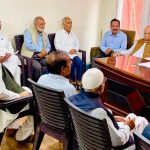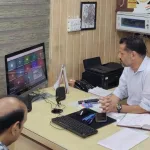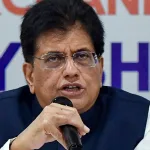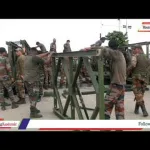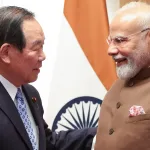The central government has made unprecedented efforts to transform Jammu & Kashmir from a conflict-hit zone into a peaceful and progressive tourist destination. A new chapter of integration, infrastructure, and investment began unfolding—particularly in the tourism sector of Jammu & Kashmir. Under the “Naya Kashmir” vision, tourist footfall broke all previous records during last few years. Forgotten and untouched border areas like Uri, Tangdhar, Teetwal, Keran, Machil, Bangus and Gurez Valley were put on the tourism map through the bold and innovative concept of Border Tourism.
This was not just about opening offbeat places to visitors, but about opening hearts, building bridges, and sending a powerful signal to the world that Jammu & Kashmir is peaceful, secure, and united with the rest of the country. The recent Pahalgam terrorsit attack on innocent tourists while tragic, must not derail the remarkable journey of revival that Kashmir has embarked upon. Rather it demands a stronger collective resolve to protect and promote the peace and prosperity that tourism brings in Kashmir.
We must except that tourism is not just an industry in Jammu & Kashmir—it is a barometer of normalcy & peace. When tourists walk freely on the streets of Kashmir they are unknowingly participating in the restoration of peace. Their presence displays confidence in governance, security, and coexistence.The revival of tourism post-attack can be a message to the enemies of peace that violence will not dictate Kashmir’s destiny and we reject it strongly.
Every tourist that chooses to return is a footstep against fear and a loud vote for peace & harmony. No doubt tourism is the economic backbone of lakhs of families in the J&K as it supports hoteliers, shikarawalas, taxi drivers, artisans, dry fruit vendors, and pony operators. For the youth of J&K, tourism is not just employment—it is empowerment and a platform to show the world that we are with the nation. New ventures, startups, and homestay schemes supported by the government have given young Kashmiris a dignified livelihood, opportunity and a stake in peace.
The government’s policies have made tourism a central component of economic development which is unprecedented step. From upgraded infrastructure to promotional campaigns, the efforts are visible and impactful. Unfortunately, when incidents like the Pahalgam terror attack occur, we must work twice as hard to prevent economic disruption and protect the aspirations of our youth and the country.
Strengthening National Unity: Tourism as a Bridge
One of the most beautiful outcomes of tourism is its power to create human bonds which is essential. When families, students, professionals visit the Valley, it without any doubt helps break decades-old barriers of misinformation, fear, and alienation. These forms of exchanges ensures people-to-people connections that reinforce the spirit of Ek Bharat, Shreshtha Bharat. We have seen how tourism bridges the emotional and psychological gap between the people of Jammu & Kashmir and the rest of India. It tells the people of Kashmir that they are loved, respected, and embraced.
And similarly, it tells the rest of India that Kashmir is not just name of a piece of land—it is a living, breathing part of our shared national identity. We need to accept that tourism introduces the rest of India to Kashmir’s pluralistic ethos and brings India’s diversity into the Valley in a spirit of mutual admiration. This cultural exchange dismantles the walls of isolation and strengthens the Indian identity of Kashmir while also preserving and celebrating its unique local traditions.
Tourism as a Tool for Peacebuilding and Global Narrative Shift
Revival of tourism is not just about economic policy—it has certainly international ramifications. A vibrant tourism scene in Kashmir defeats propaganda pushed by anti-India elements on global platforms.
In a region long projected internationally through the lens of conflict, a vibrant tourism environment defeats hostile narratives with evidence of ground realities. It provides the most humane and persuasive counter to propaganda. When international tourists post pictures or write blogs on the hospitality of Kashmiris, they unconsciously counter misinformation with lived experiences. Tourism becomes a subtle yet powerful tool of diplomacy—proving that peace is not just promised, it is practiced in Kashmir.
Those who attacked tourists in Pahalgam Valley weren’t just targeting innocent lives instead they were targeting the very idea of unity between Kashmiris and fellow Indians. These terrorists tried to make a strategic attempt to sabotage peace and normalcy because they fear what tourism represents—connection, development, and acceptance. The enemy want to isolate Kashmir and keep it trapped in a narrative of conflict. But this new Kashmir, committed to progress, refuses to be held hostage.
The more people-to-people contact establishes, the weaker divisive & narrow ideologies become. Every tourist that returns safely is a blow to nefarious agenda of the terrorism. The revival of tourism is not just about business—it is about belief in peace and in unity. The central government’s bold decisions have laid the foundation for this transformation. It is now our responsibility—as citizens of this valley to protect this progress at any cost.
When a tourist shares a photograph, a travel vlogger publishes a video or a backpacker pens a blog describing the warmth and hospitality of Kashmiri people it becomes an act of silent but strong diplomacy. These lived experiences undermine misinformation and anti-India elements on international platforms. Every shared moment becomes a testament to peace—a counter-narrative more impactful than any press release.
The terrorists knew what tourism symbolizes: integration, interdependence, development, and acceptance.Therefore, they fear that a flourishing tourism sector will uncover their irrelevance, unveil the lies they use to propagate, and forge a new people-to-people relationship that permanently closes the doors to division. What they fear most are scenes that stitch the social fabric tighter, harmony, aspiration, and coexistence.
Let’s realise that it is now our collective duty—Kashmiris and fellow Indians alike—to protect and nurture this wonderful transformation. We should not allow fear to undo what faith has begun and let us make tourism a power tool to defeat the agenda behind Pahalgam terrorist attack.
(The author has made significant contributions to the promotion of border tourism in the Kashmir Valley and has authored numerous articles highlighting dozens of lesser-known, offbeat, and border tourist destinations. Feedback: lawtahirmajeed@gmail)



